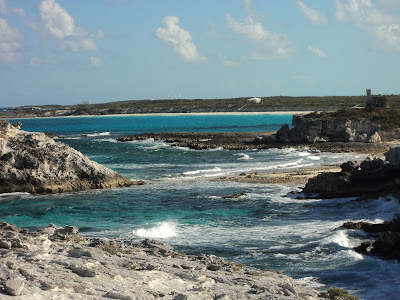 |
| Atlantis Resort, Nassau |
We woke up at midnight on January 26th with "Little Lara" hobby-horsing as the waves surged into the anchorage at Shroud Cay. The wind had shifted during the night and increased to 10-15 knots, leaving the boat exposed to the wind and waves. By 3:00 am the anchorage was so uncomfortable, we decided to leave for Nassau. As we traveled through the night, the stars were out in their abundance, as there was no moon. It was a beautiful night. By sunrise we were sailing under main and jib as we crossed Yellow Bank. This is an area of shallow water with many uncharted coral heads. As we sailed along, we could clearly see the ocean bottom as it reached up from 8-12 feet. We arrived safely in Nassau where we stayed one night at the Palm Cay Marina. Here we bought provisions, filled our water tank and topped off with diesel. Leaving the marina we cut through Nassau Harbor, after obtaining permission to do so from Harbor Patrol, as we continued our northward voyage. The harbor is congested with water taxis, fishing boats and cruise ships. We were no longer in the quiet out islands, but back in civilization with its luxury homes, high-rise apartments and five star hotels.
 |
| Bird Cay, Berry Islands |
From Nassau we sailed to the Berry Islands, anchoring off Bird Cay. We were excited to be away from the noise and congestion of Nassau, and we found Bird Cay to be a haven of beauty and tranquility. This 250 acre Tropical Island is located at the south end of the Berry Island chain. It is well protected on all sides by sand banks and islands with fun names like Cat Cay, Whale Cay, Crab Cay and Chub Cay. Bird Cay was recently listed for sale and can be purchased for a mere $8,900,000, if you are interested.
 |
| Berry Island Club |
The next morning we learned that another winter storm was headed our direction, so we decided to move "Little Lara" to Chub Cay where we hoped to gain more all around weather protection. Marine life around Chub Cay is prolific with an abundance of coral reefs, billfish, bonefish, turtles, lobster and conch in the waters surrounding the island. This entire area is within the Southern Berry Islands Marine Reserve. We anchored off Berry Island Club, which was closed for renovations and repairs due to Hurricane Mitchell. Never-the-less, we enjoyed exploring the island, walking the roads, and visiting nearby Cat Cay.
We were blessed, experiencing none of the projected high wind and seas, so we decided to leave the Berry Islands on January 31st for Florida. The revised forecast was calling for light winds and calm seas, a perfect opportunity to make the 135 mile overnight trip. But, before reaching Fort Lauderdale, we would have to cross the Tongue of the Ocean and the Gulf Stream.
 |
| Tongue of the Ocean and Andros Island |
The Tongue of the Ocean is a U-shaped, relatively flat-bottomed trench approximately 20 miles wide by 150 miles long. Its depth varies gradually from 3,600 feet in the south to 6,600 feet in the north. It is one of the world’s deepest undersea canyons in the world. It lies between Andros Island and New Providence Island.
 |
Gulf Stream
(In Red) |
The Gulf Stream, on the other hand, is a powerful, warm, and swift Atlantic ocean current that originates in the Gulf of Mexico and stretches around the tip of Florida, and follows the eastern coastlines of the United States before crossing the Atlantic Ocean. The velocity of the Gulf Stream current is fastest near the surface, with the maximum speed of 5.6 miles per hour and an overall average speed of four miles per hour. The Gulf Stream transports nearly four billion cubic feet of water per second, an amount greater than that carried by all of the world's rivers combined. This means we could not sail "Little Lara" straight to Florida, but would have to head southward as the currents pushed us northward, leaving an elongated "S" shaped track as we crossed this body of water.
 |
| "Little Lara's" 135 mile track from Chub Cay to Fort Lauderdale |
 |
"Little Lara"
ready for shipment to California |
As we sailed through another moonless night, we found comfort in the loom of Fort Lauderdale's night lights as they lit up the horizon, which we could see from 40 miles away. We arrived in Florida on February 1st after a 27 hour passage. Shortly thereafter, we loaded "Little Lara" on a transport for the 3500 mile trip back to California where she will once again be sailing in the waters of San Francisco Bay. Thus, our Bahama adventure comes to an end. What memories! What friends! We hope all your memories are as wonderful regardless of where your travels take you. And, may you too find fair winds.
 |
| Visiting family in Utah |




























